Protecting the northern portion of the Florida Reef, one of the world’s largest coral reefs, Biscayne National Park is a subtropical paradise. Located just south of Miami, Biscayne is mostly water, but there are still many fun things to do in this unique national park.
The sprawling, shallow waters of Biscayne Bay make up no less than 95% of the park. The rest is divided between a number of small islands, called ‘keys,’ and a stretch of mangrove-lined coastline on the southeast Florida mainland.
Most of the things to do in Biscayne National Park are water-based. You can go boating, kayaking, fishing, and snorkeling or scuba diving. There are, however, also a (very) limited number of land-based activities in Biscayne National Park.
Below, you’ll find all of the best things to do in Biscayne National Park, one of largest marine preserves in the United States.
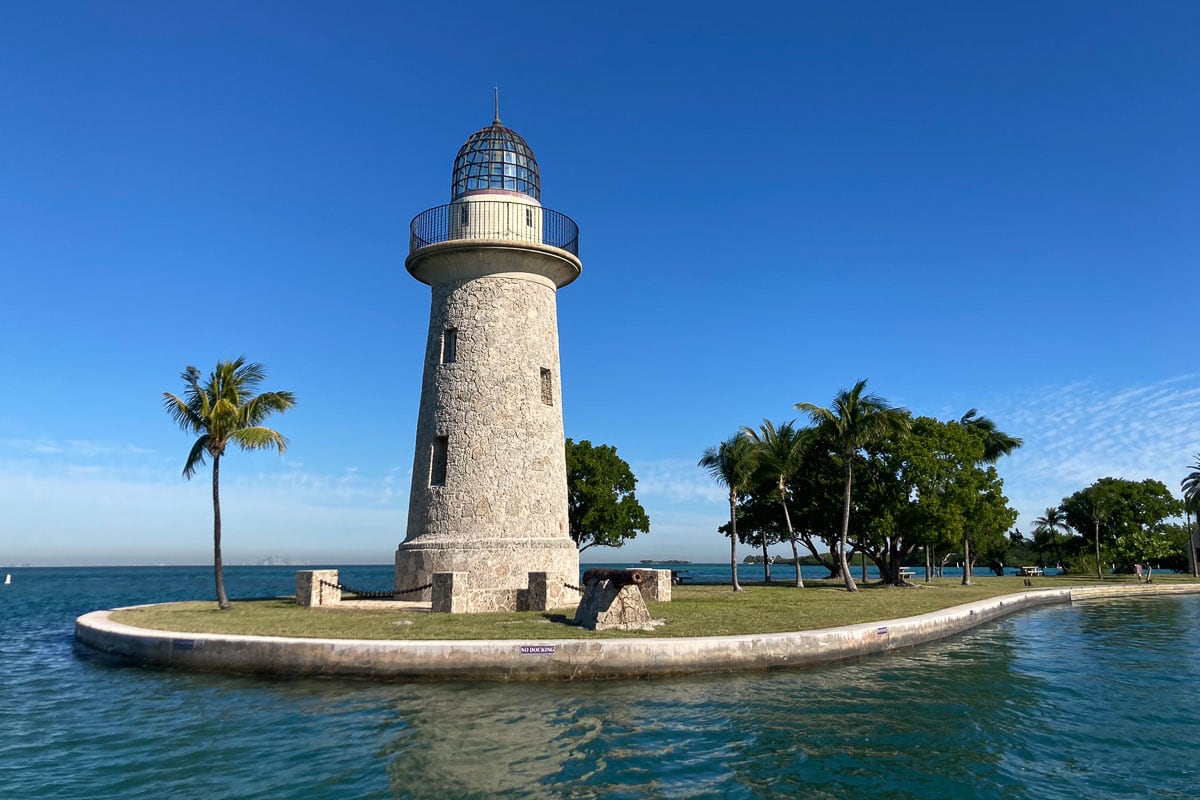
This blog post about the best things to do in Biscayne National Park contains affiliate links. You can read more about our Terms of Use / Disclosure here.
Contents
- Visiting Biscayne National Park FAQs
- How Do You Get to Biscayne National Park?
- How Do You Get Around Biscayne National Park?
- How Much Time Do You Need to Experience Biscayne National Park?
- What Is the Best Time to Visit Biscayne National Park?
- How Much Is the Entrance Fee to Biscayne National Park?
- What Should You Bring on a Trip to Biscayne National Park?
- Best Things to Do in Biscayne National Park
- 1. Visit the Dante Fascell Visitor Center
- 2. Watch One of the Biscayne National Park Films
- 3. Explore the Convoy Point Jetty Walk
- 4. Kayak Along the Mangrove-Lined Shoreline
- 5. Go on a Guided Boat Tour
- 6. Visit Famous Boca Chita Key
- 7. Learn About the Fascinating History of Stiltsville
- 8. Go Fishing in Biscayne Bay
- 9. Snorkel or Scuba Dive in Spectacular Coral Reefs
- 10. Look For Wildlife
- 11. Go Camping on a Florida Key
- Additional Biscayne National Park FAQs
- More About Biscayne National Park
- More About the National Parks in Florida
Visiting Biscayne National Park FAQs
Before we get to the top things to do in Biscayne National Park, let’s answer some common questions about the park.
Visiting Biscayne is pretty easy, thanks partially to its proximity to Miami and Miami Beach, but you do need to do some planning if you’d like to go beyond the visitor center on the mainland.
This is especially the case if you’re planning to explore the waters of Biscayne Bay by boat—boats are the only way to do that. For example, guided boat tours require reservations, so make sure to get your tickets well in advance. They can and do sell out.
How Do You Get to Biscayne National Park?
Biscayne National Park is on and off the coast of southeast Florida. It protects most of Biscayne Bay between Key Biscayne and Key Largo, just south of Miami and east of Homestead.
The best way to get to Biscayne National Park is by car. The National Park Service encourages people to allow extra time to get there, though, saying that “[h]eavy South Florida vehicle traffic can cause delays.”
“Please allow plenty of time for driving to and from the park, especially on weekends, holidays and rush hours. The Florida Turnpike is the best route to avoid delays (U.S. Highway 1 is usually a slow and arduous journey),” the Park Service says.
These are the approximate driving times and distances from various nearby locations to the Dante Fascell Visitor Center:
- Fort Lauderdale: 1 hour 20 minutes / 64 miles
- Fort Lauderdale-Hollywood International Airport (FLL): 1 hour 15 minutes / 64 miles
- Miami Beach: 1 hour 15 minutes / 42 miles
- Miami: 1 hour / 38 miles
- Miami International Airport (MIA): 45 minutes / 34 miles
- Homestead: 20 minutes / 10 miles
- Key Largo: 40 minutes / 33 miles
- Everglades National Park (Royal Palm): 40 minutes / 24 miles
- Everglades National Park (Shark Valley): 1 hour 15 minutes / 50 miles
- Everglades National Park (Flamingo): 1 hour 15 minutes / 57 miles
Alternatively, you can also take public transportation to Biscayne National Park. From downtown Homestead, the “Gateway to Everglades and Biscayne National Parks,” you can take the Homestead National Parks Trolley to the Dante Fascell Visitor Center.
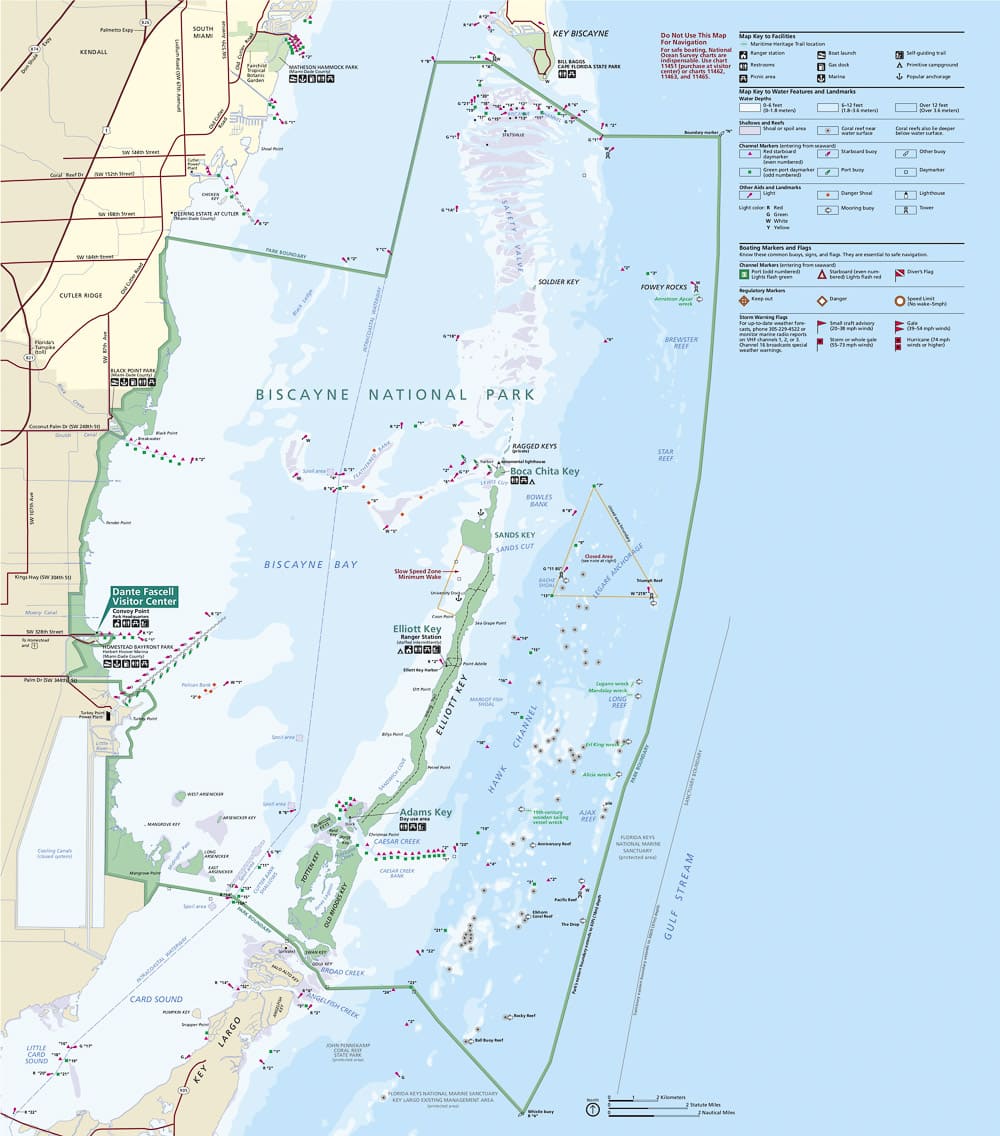
How Do You Get Around Biscayne National Park?
Unlike most other national parks in America, Biscayne does not have any roads.
The only exceptions are the short roadways to the Dante Fascell Visitor Center at Convoy Point and to Homestead Bayfront Park. Together, those roads total no more than 1 mile in length.
This is to say that getting around Biscayne National Park is very much a boat-centered affair. In fact, boats are the only way to explore this marine park with more than 250 square miles of water.
Private Boats
If you have your own boat, you can travel into the park from four different marinas, operated by Miami-Dade County.
The Homestead Bayfront Marina and Black Point Marina are within the national park boundary. The Matheson Hammock Marina and Crandon Marina, on the other hand, are outside the park, but do offer easy access to it.
See the park’s website for more information about private boats in Biscayne National Park.
Guided Tours
Most visitors don’t have their own boat, of course. Luckily, there are various guided tours available in Biscayne National Park. Those range from kayaking excursions and half-day boat tours to full-day snorkeling cruises and two-day Biscayne Bay sailing adventures.
The go-to operator for guided tours in the park is the Biscayne National Park Institute. Visit their website to see their extensive offering of guided tours. Guided boat tours are the most popular way to explore Biscayne National Park.
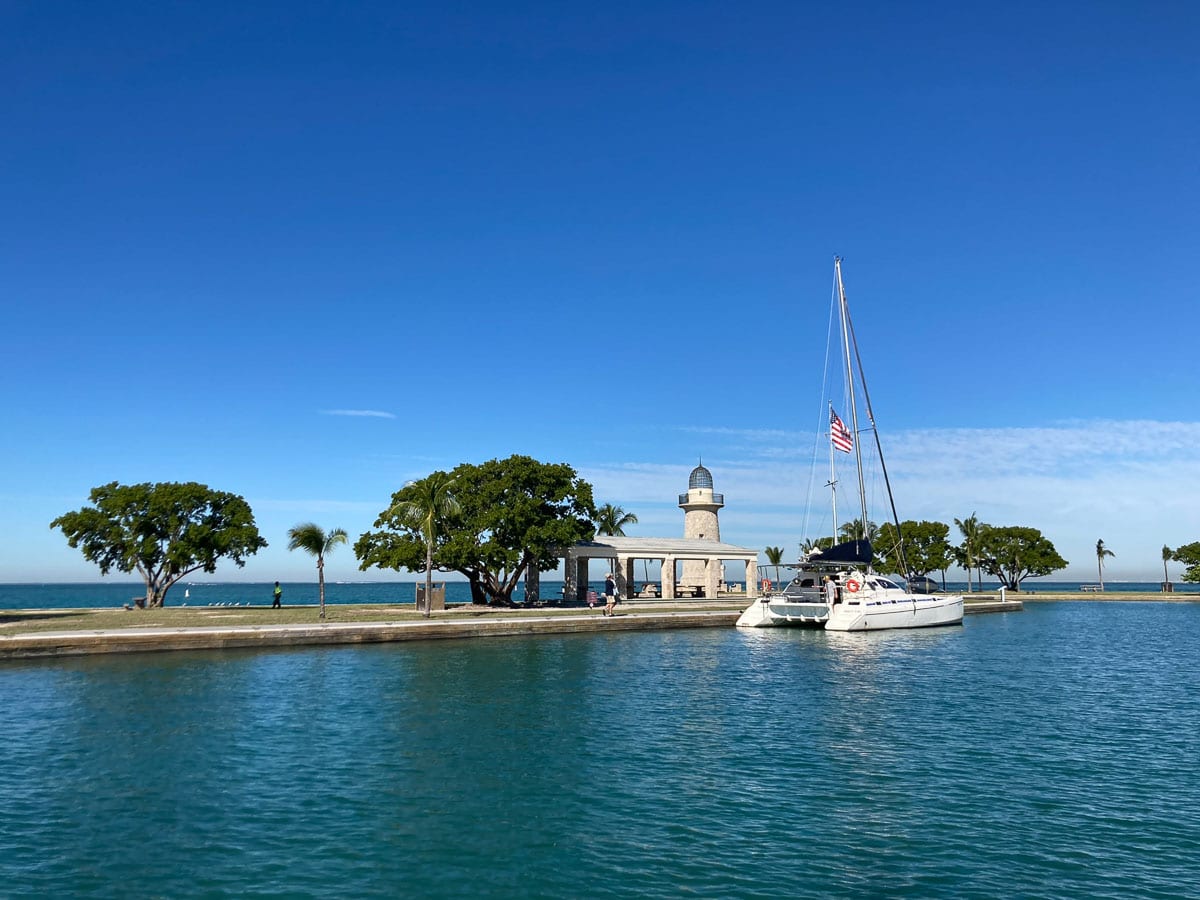
How Much Time Do You Need to Experience Biscayne National Park?
Very few visitors spend more than one full day in Biscayne National Park. Beyond the Dante Fascell Visitor Center area, the only way to see the park is by boat.
Many people who visit Biscayne opt for a day trip by boat. Depending on which boat tour you choose, you should be able to do most of the Biscayne National Park activities described below in just one day. (The last featured activity is camping, which, of course, means more than one day in the park.)
When picking a guided boat tour, I recommend looking for one that includes several of the top Biscayne National Park attractions highlighted in this post. Try not to skip places like Boca Chita Key and Stiltsville.
What Is the Best Time to Visit Biscayne National Park?
Thanks to its subtropical climate, Biscayne National Park is an enjoyable destination all year round. There are basically two seasons here: the dry winter and the wet summer.
Dry Season (Winter)
Late-November through April is the dry season, which brings dry and mild weather. Occasional fronts can cause stronger winds and a bit of rain. Although those winds can create lower underwater visibility, they also blow away any mosquitoes.
That being said, severe storms and heavy rain showers are exceptionally rare this time of year, making the winter dry season arguably the best time to visit Biscayne National Park.
This is especially true when considering the cold and/or wet weather elsewhere in the United States in winter. Simply put, Biscayne is a phenomenal winter holiday destination—truly one of the best in the country.
For reference, the average high temperature in January is 77 degrees Fahrenheit, while the average January rainfall is 1.93 inches.
Wet Season (Summer)
The wet season runs from May through October. This time of year comes with hot weather, regular rainfall, and high humidity. Summer is also mosquito season in this region, which can be absolutely relentless in the coastal mangroves.
On the bright side, summer is a great time to explore Biscayne’s spectacular underwater world. Unless there’s a rain shower or storm, visibility is typically excellent this time of year.
Note, though, that Florida’s hurricane season runs from June through November. Keep an eye on the storm forecast when visiting the region in that period.
The average high temperature in August is 90 degrees Fahrenheit. Average August rainfall is 9.17 inches.
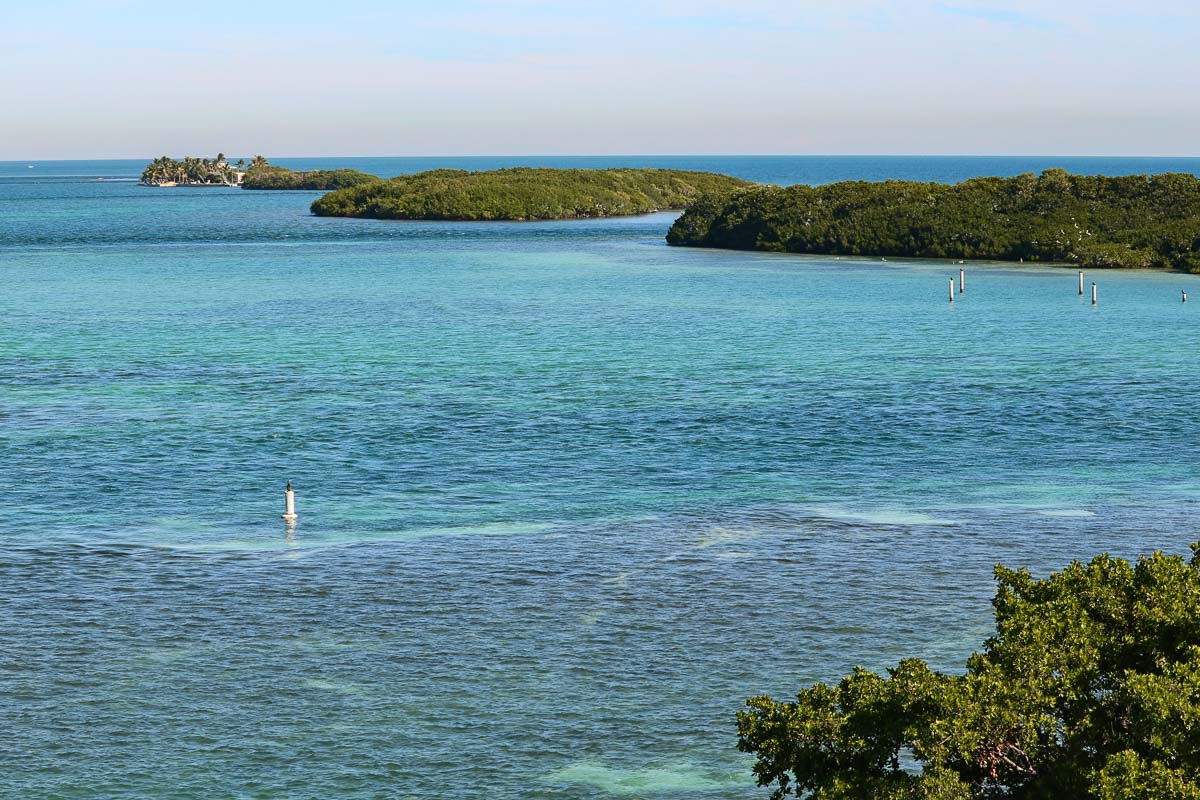
How Much Is the Entrance Fee to Biscayne National Park?
Visiting Biscayne National Park is completely free. The park does not charge any entrance fees.
What Should You Bring on a Trip to Biscayne National Park?
Although there are no beaches to swim at in Biscayne National Park, you should treat a visit to the park as a beach trip. This means you should bring things like sunscreen, sunglasses, a hat, snacks, and water.
If you’re also going snorkeling or scuba diving, make sure to bring a towel, underwater camera, and a bathing suit. A dry bag for valuable items like wallets, keys, and phones is always a good idea, too.
- Reef-safe sunscreen
- Hat
- Bathing suit
- Towel
- Sunglasses
- Binoculars
- Camera
- GoPro or another type of small underwater camera
- Comfortable shoes
- Dry bag for valuable items
- Snacks and a refillable water bottle
- Lunch (for full-day boat trips)
Best Things to Do in Biscayne National Park
Now that you know some important background information, let’s move on to the top things to do in Biscayne National Park.
Even though you’ll probably “only” visit the Dante Fascell Visitor Center area and go on a boat tour, that does include several major highlights of the park.
From shorelines strolls and park films to exploring islands, wildlife viewing, snorkeling and scuba diving, there’s plenty to see and do in Biscayne, even in just one day!
1. Visit the Dante Fascell Visitor Center
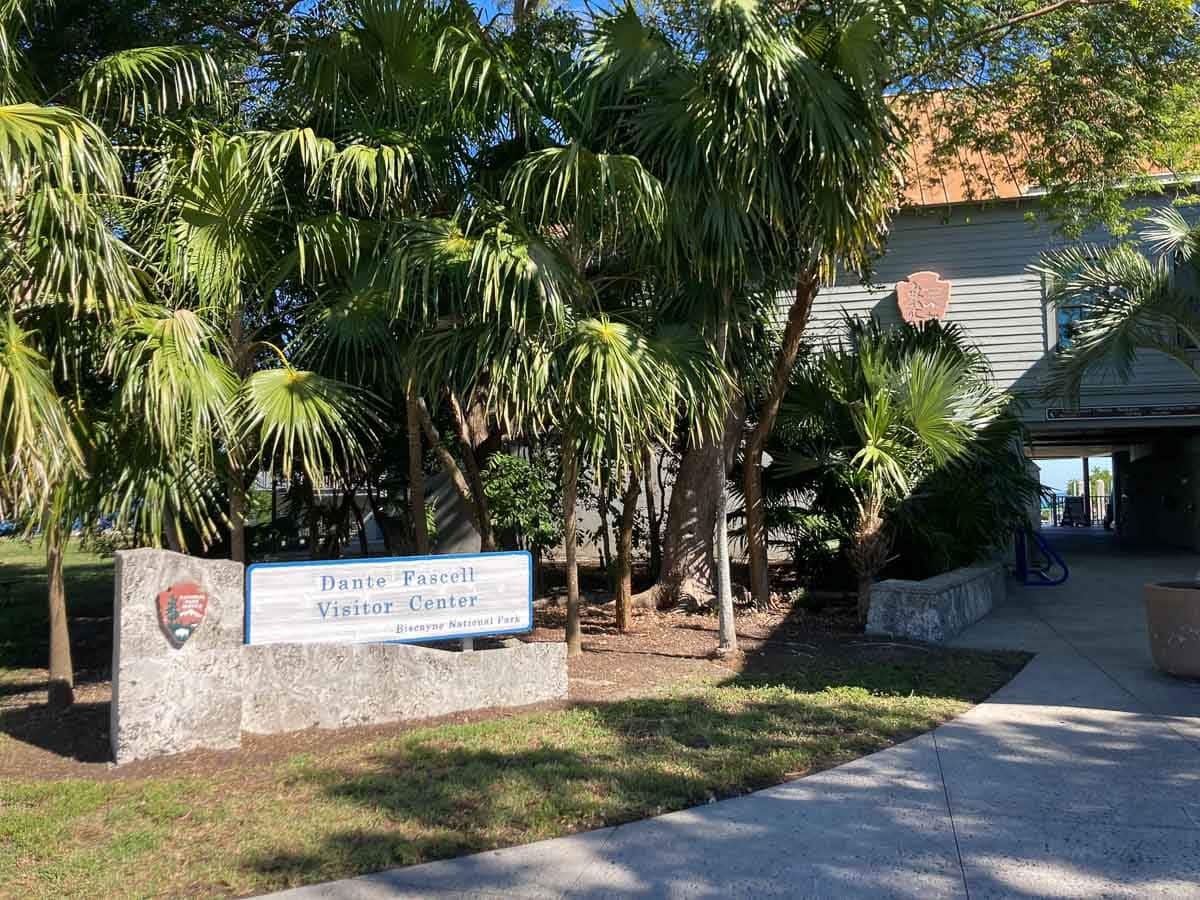
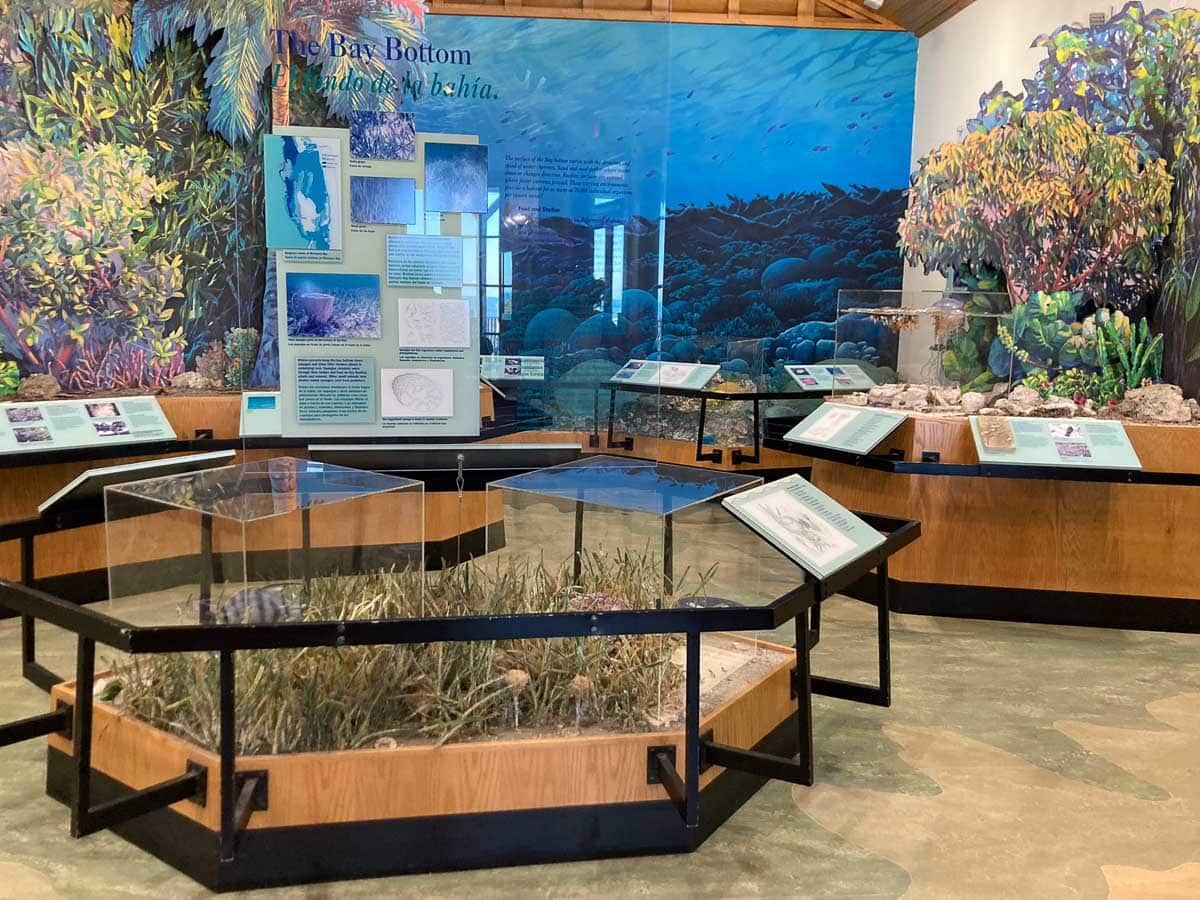
Located at Convoy Point, about 9 miles east of Homestead, the Dante Fascell Visitor Center is the centerpiece of the park’s only accessible land area.
I always recommend starting your visit to a new national park at its visitor center, advice that applies to Biscayne National Park as well.
The Dante Fascell Visitor Center has plenty of information about things to do in Biscayne National Park, while its excellent museum takes visitors on a visual journey through the four ecosystems in the park.
There are audio and video exhibits, as well as beautiful dioramas featuring the park’s rich plant and animal life.
Additionally, the Dante Fascell Visitor Center Gallery showcases the work of contemporary artists who draw inspiration from the natural beauty of Biscayne National Park and South Florida. It’s a wonderful place to spend some time before (or after) a guided boat tour.
The visitor center is open every day of the year, from 9 am to 5 pm.
2. Watch One of the Biscayne National Park Films
At the Dante Fascell Visitor Center, you can also watch several park films about various topics related to the national park, including Biscayne’s 20-minute feature film.
I strongly recommend watching one of the films—you can ask a ranger to play the film you prefer to watch. Whichever one you choose, it’ll be a great introduction to the park’s history, people and/or natural resources.
3. Explore the Convoy Point Jetty Walk
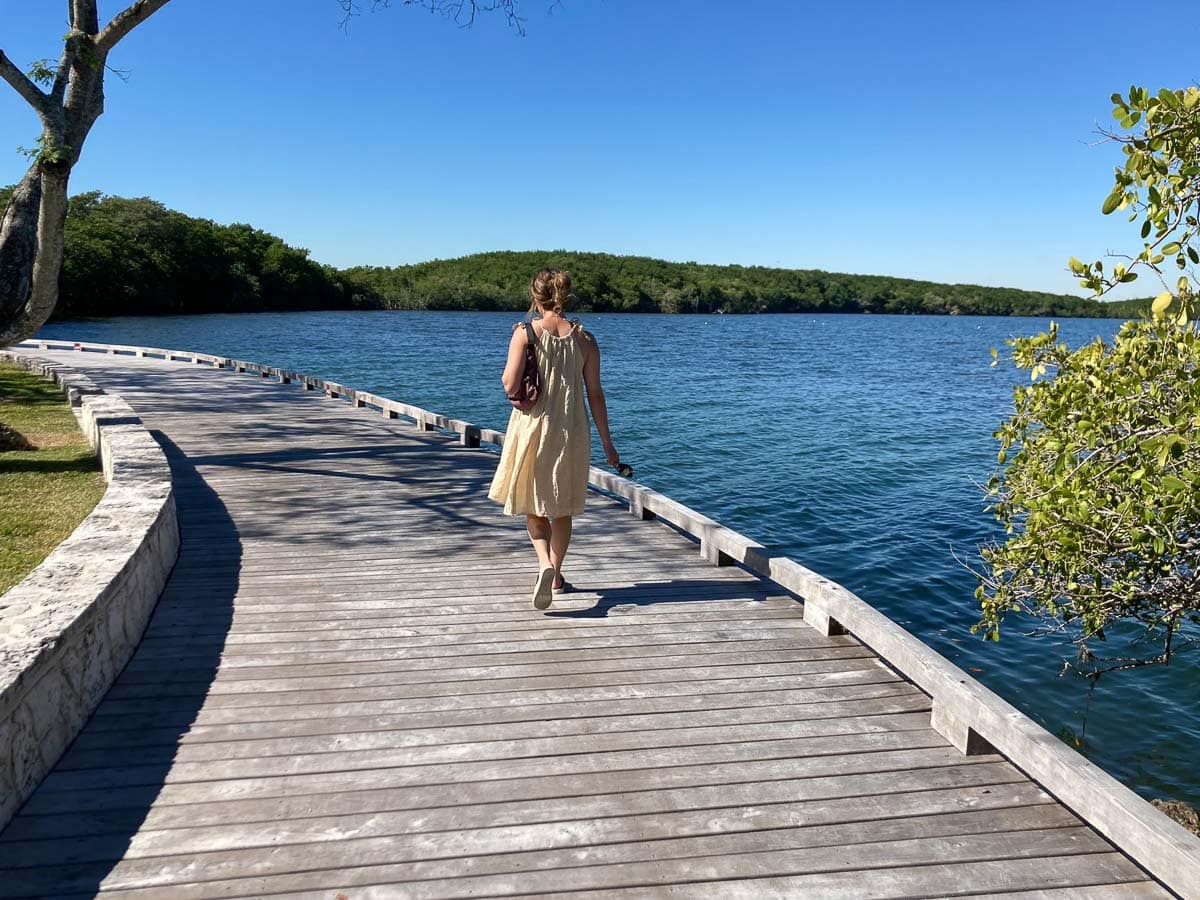
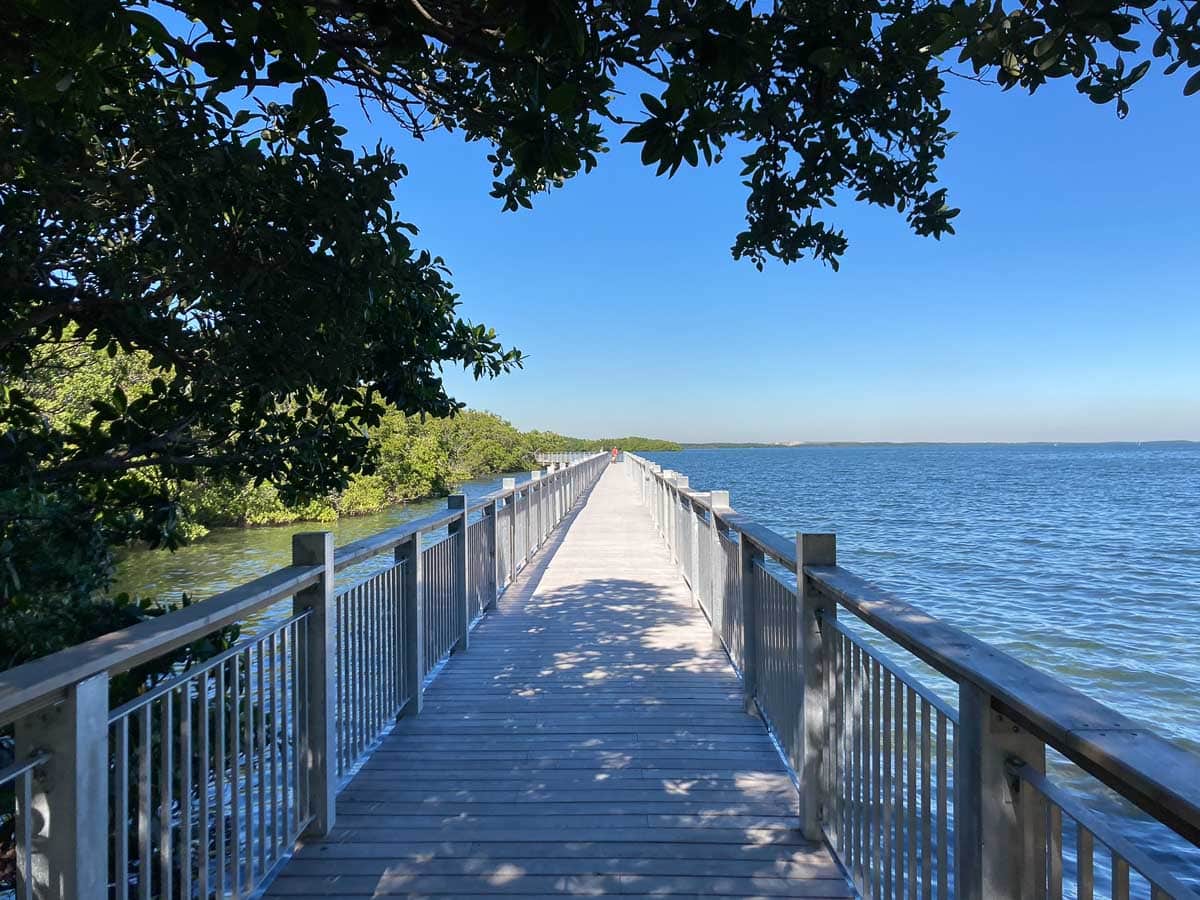
If you’d like to go for a walk in Biscayne National Park, your options are extremely limited. Besides a couple of trails on the distant keys, there’s only one walking trail on the mainland—the Convoy Point Jetty Walk. But it’s a really nice one, though.
Starting at the Dante Fascell Visitor Center, this part-pavement, part-boardwalk, part-gravel trail runs along a section of Biscayne Bay shoreline. It’s a wonderful self-guided trail with ten points of interest called “stations.”
The total roundtrip distance is 0.8 miles, but there’s a shorter 0.6-mile option as well. You’ll get to walk through mangroves, learn about the area’s fascinating history—it’s somewhat of a miracle the park exists in the first place—and maybe even see some wildlife.
You can learn more about the highlights of the Convoy Point Jetty Walk here on the park website.
4. Kayak Along the Mangrove-Lined Shoreline
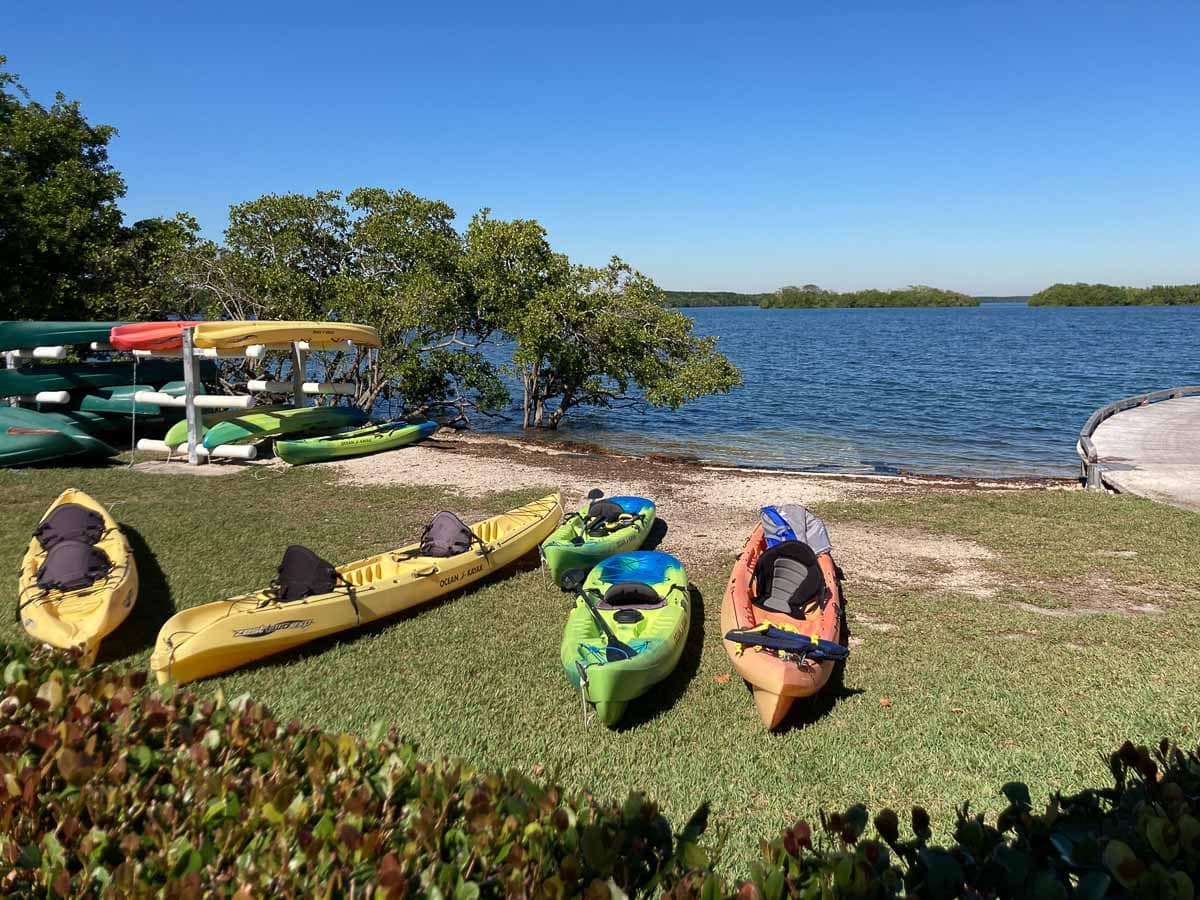
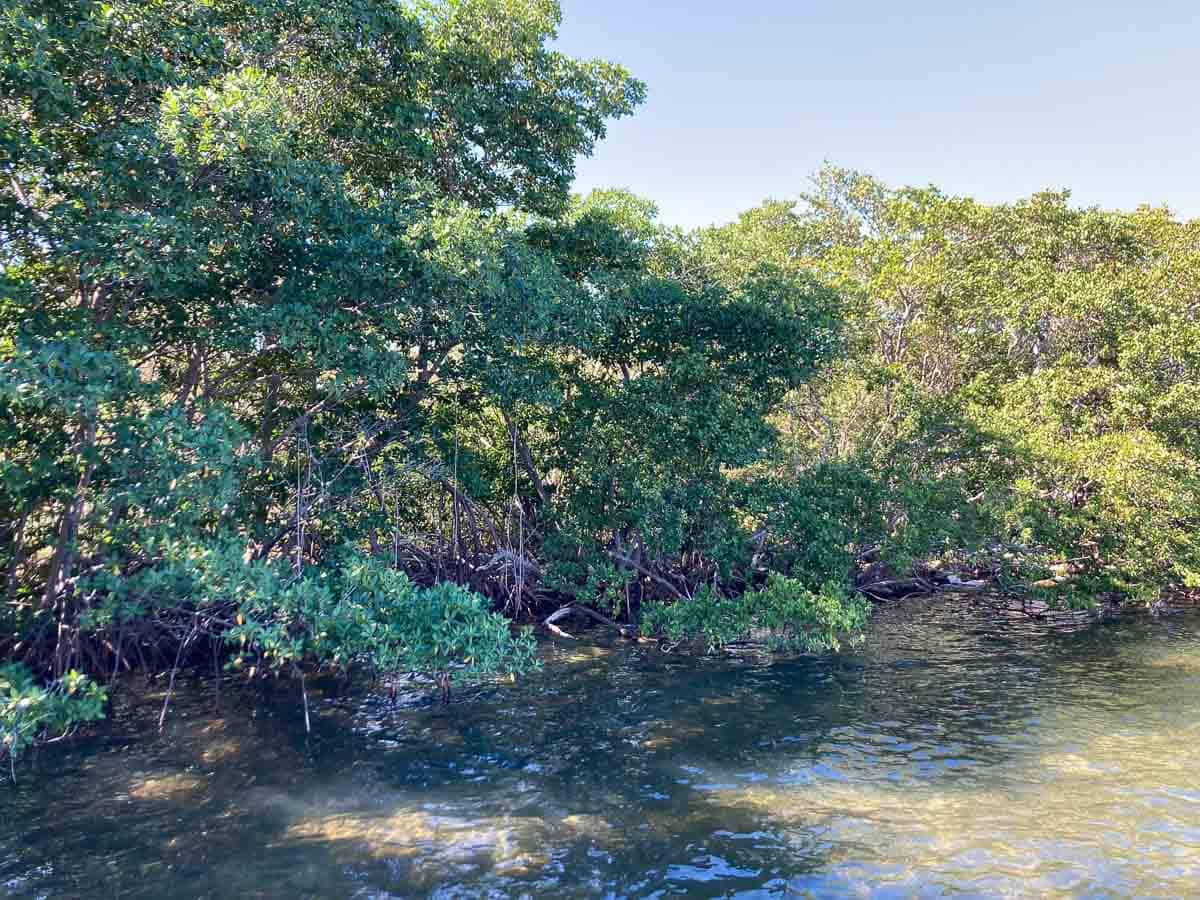
If you don’t have your own canoe, SUP or kayak, the Biscayne National Park Institute offers a wide range of paddling adventures in Biscayne Bay.
You’ll get to explore the beautiful mangrove-fringed shoreline of shallow Biscayne Bay. This is a great way to get up close to the park’s wildlife, whether it’s fish, birds or, if you’re very lucky, even the occasional American crocodile.
Excursions depart from the visitor center, while there are also options to explore the more remote keys, including gorgeous Jones Lagoon, by kayak or SUP.
See the Biscayne National Park Institute website for information about paddling trips.
5. Go on a Guided Boat Tour
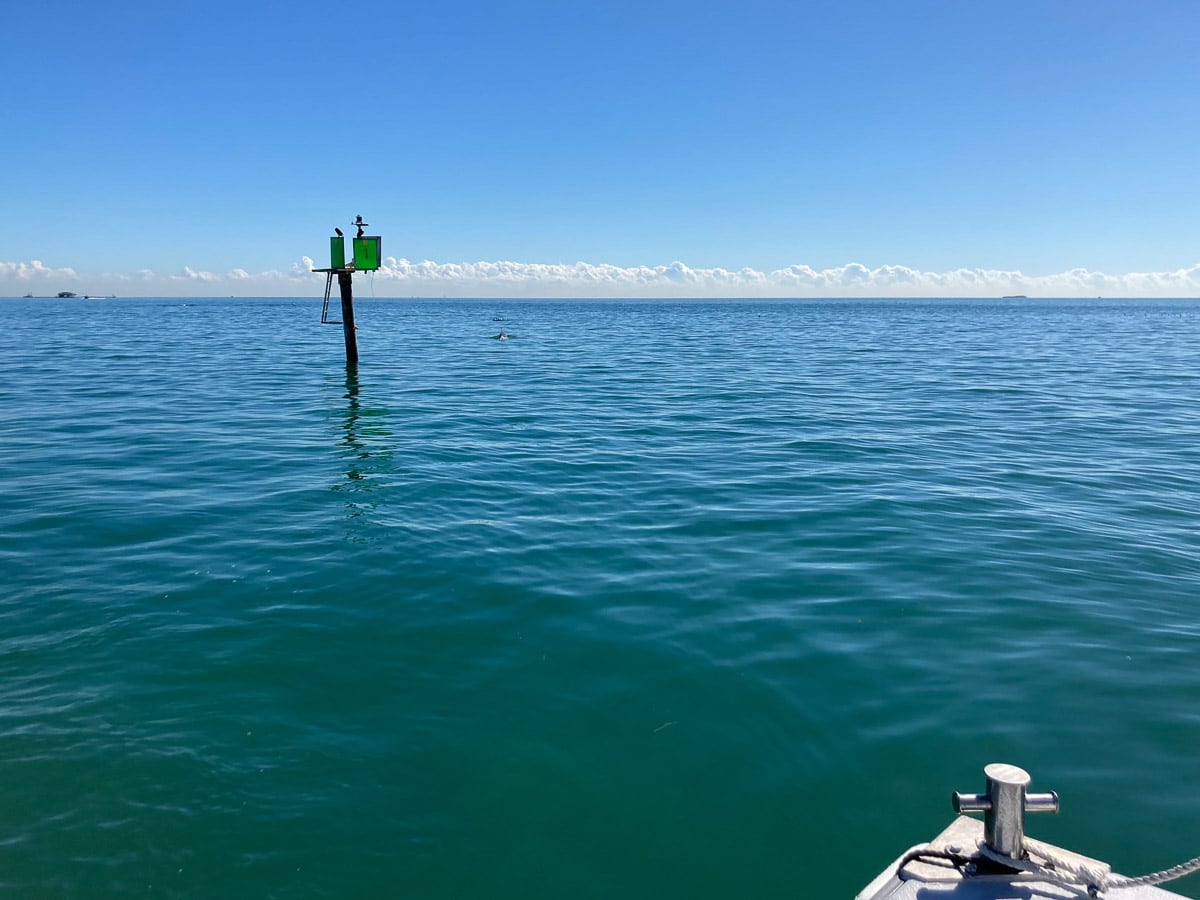
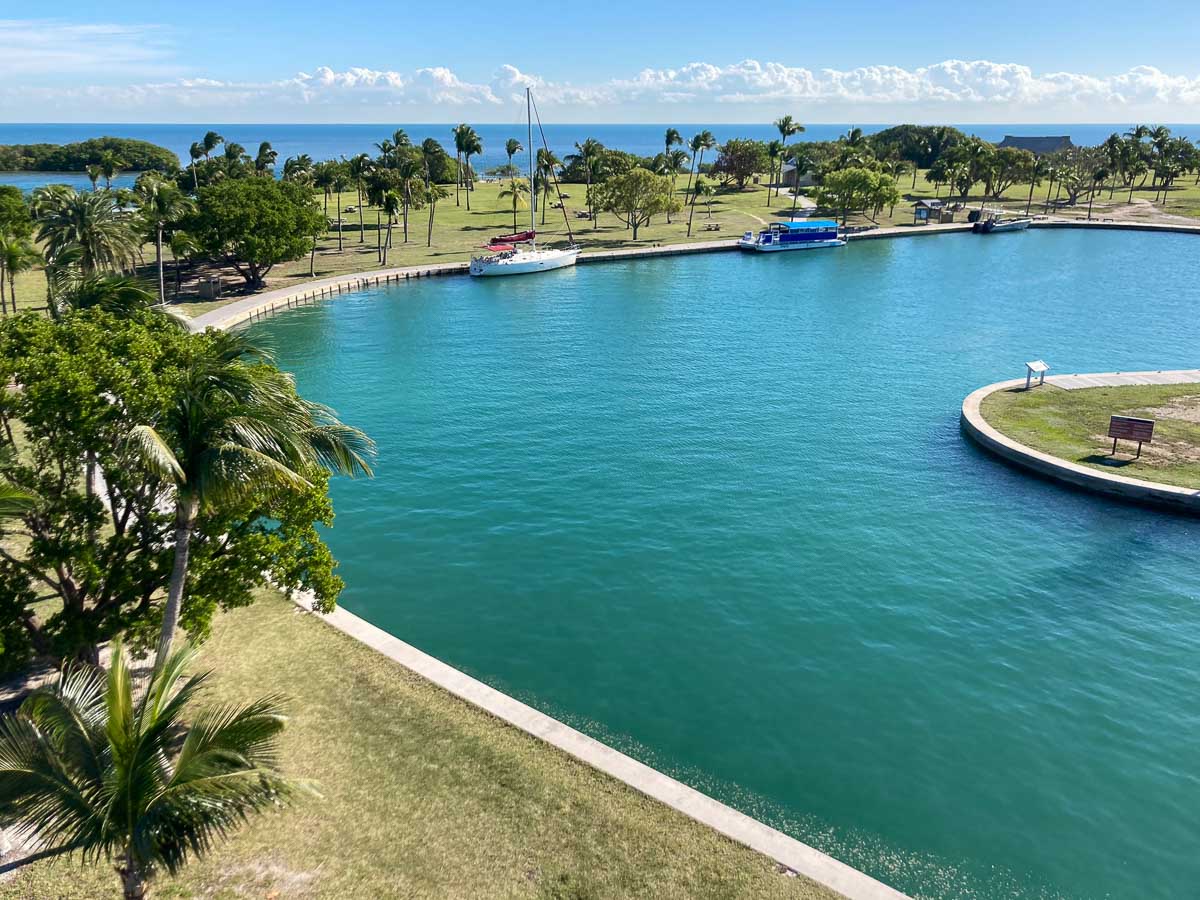
Numerous guided boat tours are available to visitors, from half-day trips to full-day excursions and even overnight sailings.
To really experience Biscayne National Park, joining a guided boat tour is a must. After getting oriented at the visitor center, a boat tour is where the real Biscayne is found.
You’ll cruise across shallow Biscayne Bay, which always offers some exciting wildlife viewing opportunities—I saw a dolphin and several water birds.
Depending on the type of tour you choose, the trip may include a visit to Boca Chita Key and its iconic lighthouse, a cruise through Stiltsville, a couple of hours of snorkeling at coral reefs or shipwrecks, and/or the option to go paddling around the keys.
Which tour you choose isn’t really that important. They’re all nice. What is important, however, is that you actually go on a boat tour. It’s truly the only way to really experience and explore Biscayne National Park.
Once again, it’s the Biscayne National Park Institute that provides these amazing guided boat tours.
Check their website for an overview of all trip options. (Remember to book these boat tours well in advance. They can and do sell out.)
6. Visit Famous Boca Chita Key
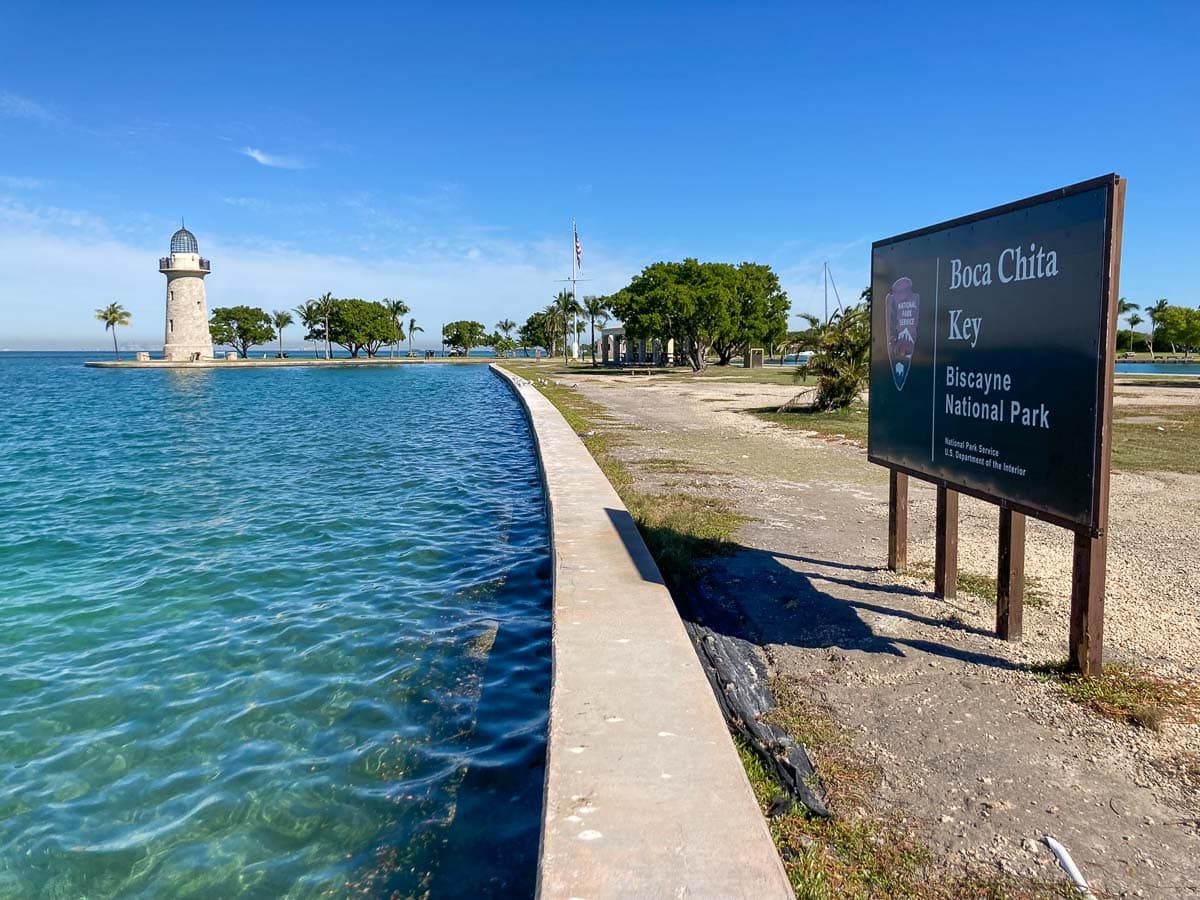
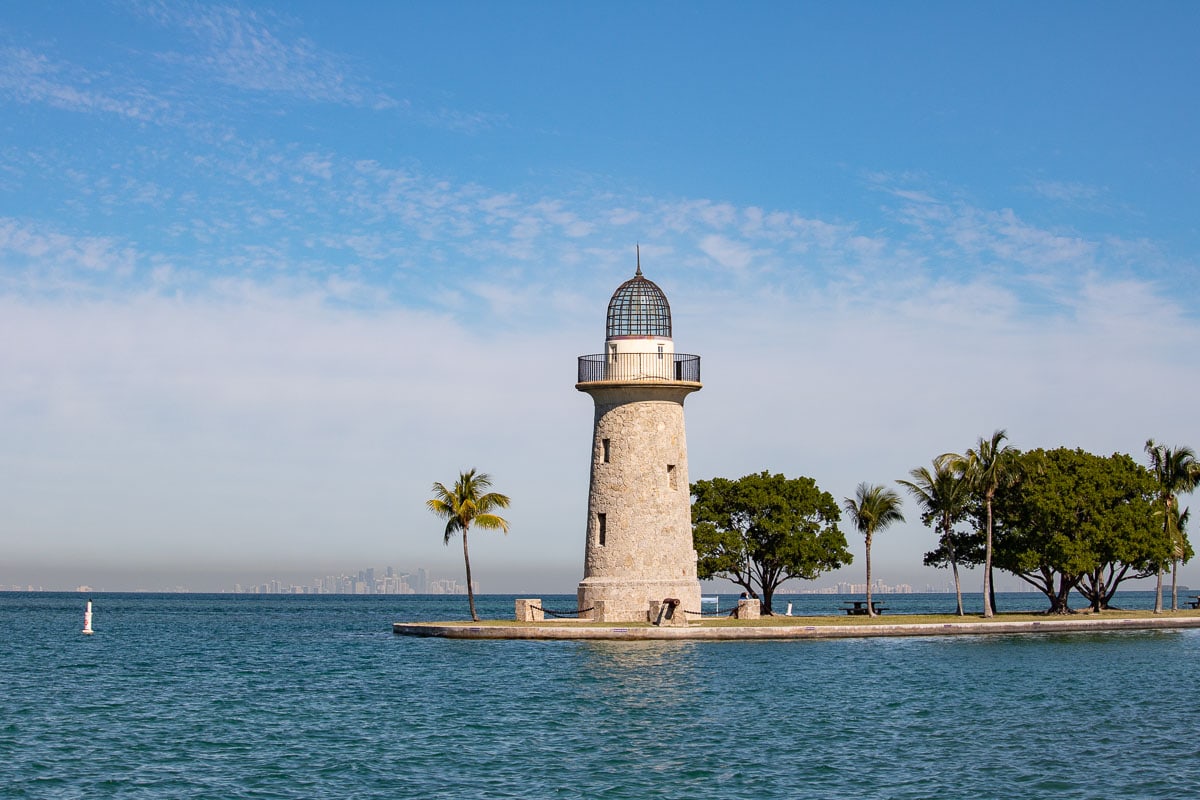
The most visited island in the park, Boca Chita Key is an absolute gem. This is one of the top attractions in Biscayne National Park and I recommend choosing a boat tour that includes a visit to this tiny island.
Boca Chita Key was once owned by the wealthy industrialist Mark C. Honeywell, who built the island’s iconic lighthouse in the 1930s, as well as a picnic pavilion, chapel, and generator room.
The area that encompasses these historic structures is now preserved as the Boca Chita Key Historic District.
On a visit to Boca Chita Key, you can explore this historic island, walk a short half-mile trail through the mangroves, and enjoy views of the Miami skyline in the distance. There’s a campground here as well.
Some wildlife is usually present, too. When I visited Boca Chita, I saw a group of beautiful white ibis, several other birds, and even a shark in the shallow water just offshore.
When you visit the island as part of a Biscayne National Park Institute boat tour, the guide might also open up the lighthouse, providing access to its panoramic observation deck.
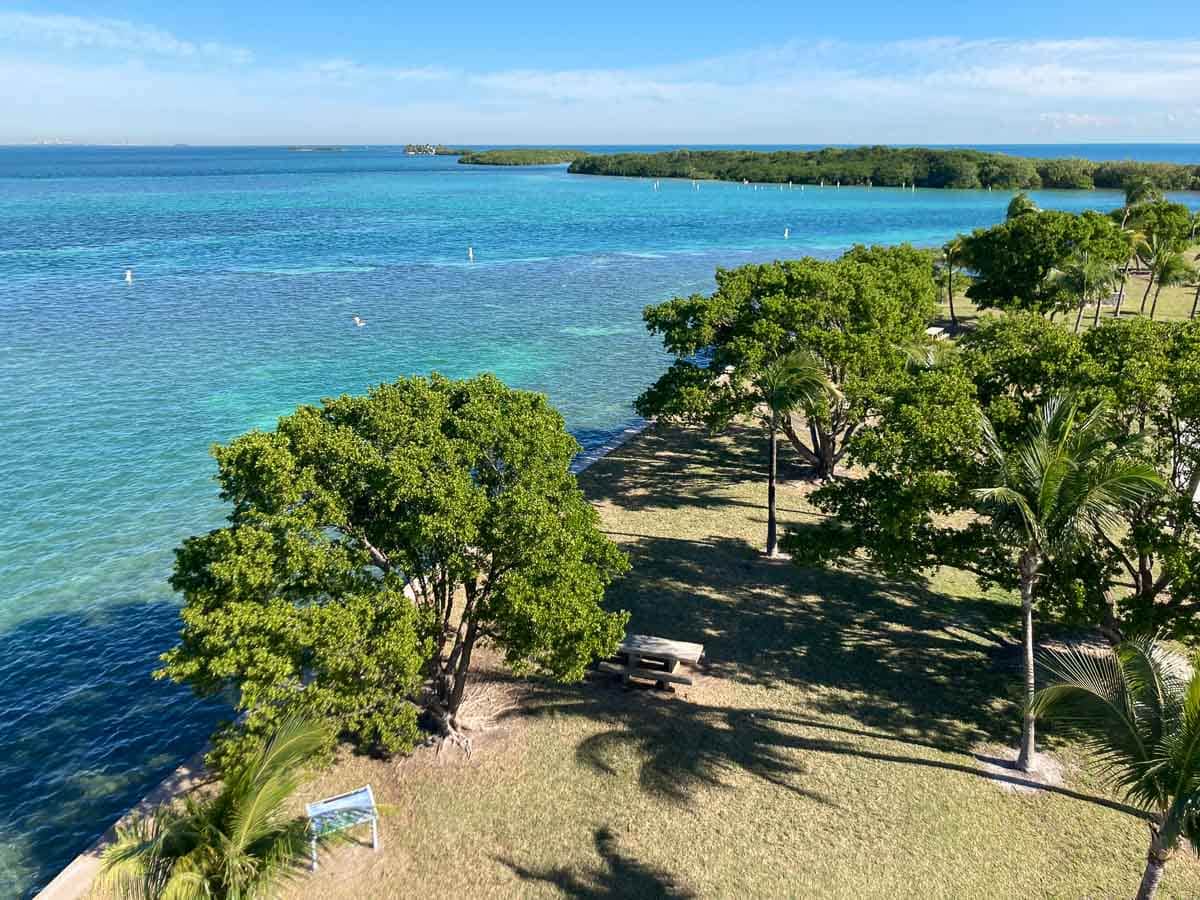
Other Florida Keys You Can Visit in Biscayne National Park
Besides Boca Chita Key, two other keys are open to the public, too. Each has its own characteristic features and possible activities.
- Elliott Key: the park’s largest island, once a vibrant community of pioneers, pineapple farmers, privateers and pirates; now home to a campground, hiking trail, swimming spots and picnic area.
- Adams Key: located on the north side of Caesar Creek, a day-use area featuring a short trail, toilets and picnic pavilion; once the location of the Cocolobo Club, a retreat for Carl Fisher and several U.S. Presidents, including Hoover, Johnson and Nixon.
7. Learn About the Fascinating History of Stiltsville
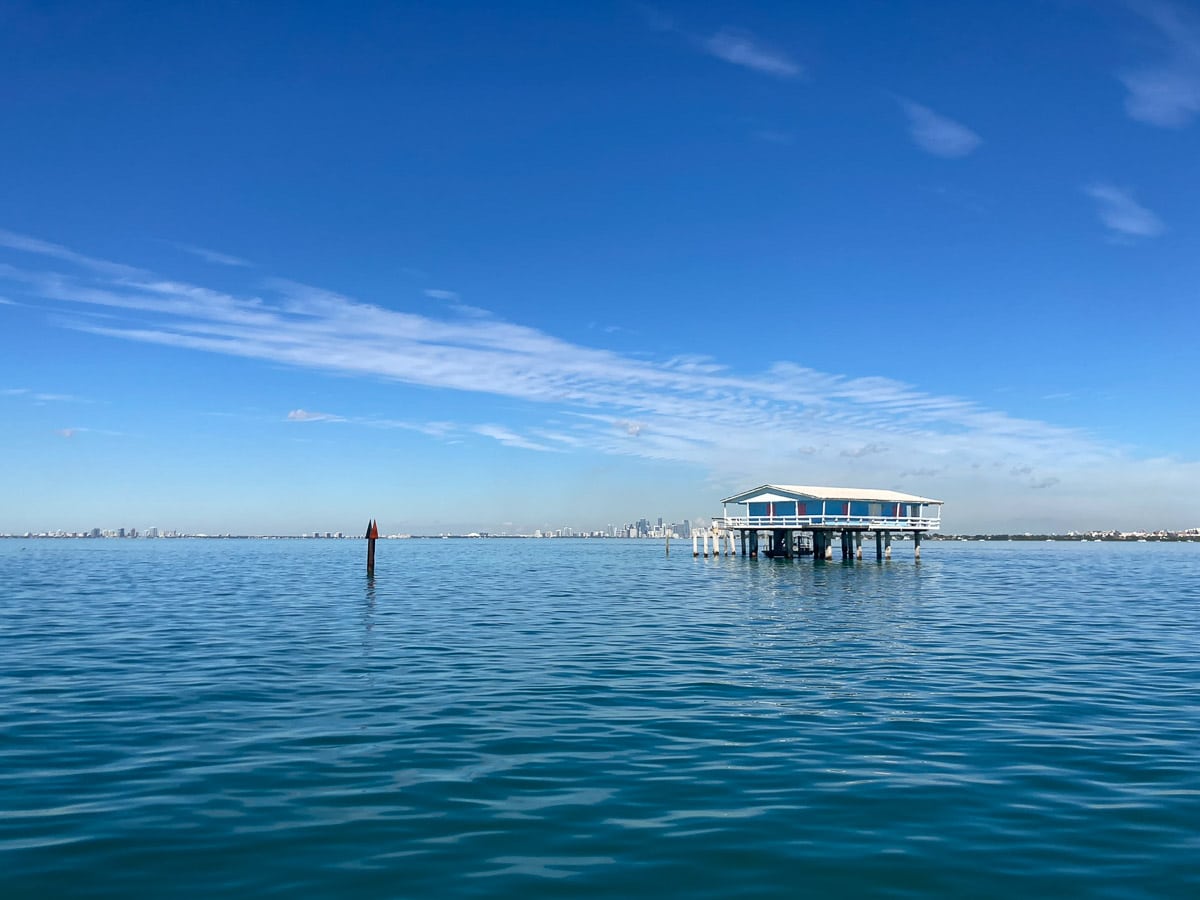
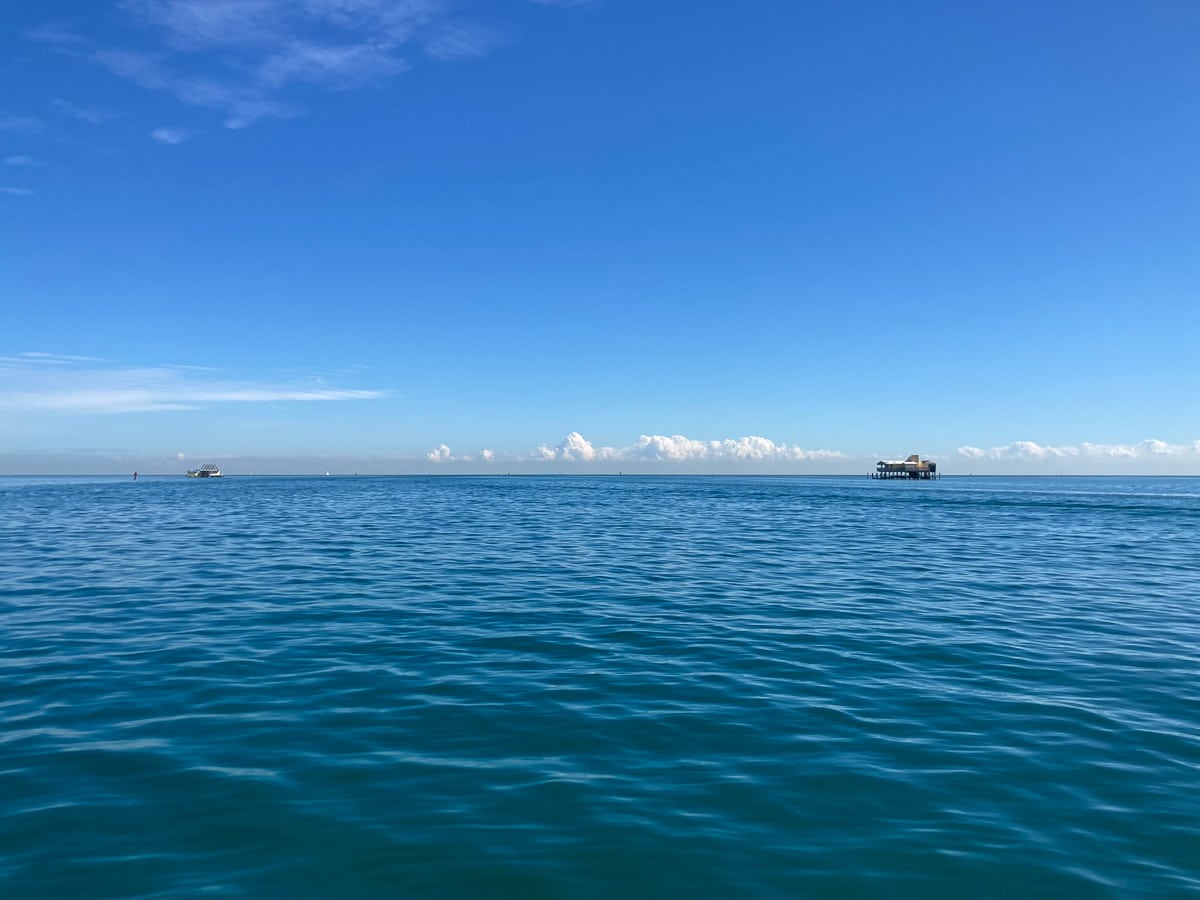
Easily one of the most unusual features of any national park, Stiltsville is a collection of stilted structures that dot the northern portion of Biscayne Bay, just south of Key Biscayne.
The rich history of Stiltsville starts in the 1930s when “Crawfish” Eddie Walker constructed the area’s first shack on stilts. First used as a bait shop and basecamp for fishing trips, Walker soon also began selling food and (unlicensed) alcohol from his shack.
More and more stilted shacks sprang up in the vicinity and the first Stiltsville social club was established in the late-1930s.
Stiltsville quickly became a place to see and be seen for wealthy winter visitors to nearby Miami Beach, including bankers, politicians, lawyers and celebrities.
However, rumors of gambling and illegal alcohol resulted in several police raids, specifically on the Quarterdeck Club and Bikini Club, a notorious club that served free drinks to women who wore bikinis.
By 1960, there were no fewer than 27 stilted shacks in Stiltsville, most of which were destroyed by hurricanes in subsequent decades. Nowadays, there are seven structures left in Stiltsville, none of which existed in its 1960s heydays.
Stiltsville is currently managed by the non-profit Stiltsville Trust. All structures are off limits to the public, but you can cruise past them on a guided boat tour, which I highly recommend since this is an important and fascinating piece of South Florida history.
The tour guides will be able to tell you much more about the people and stories of Stiltsville.
8. Go Fishing in Biscayne Bay
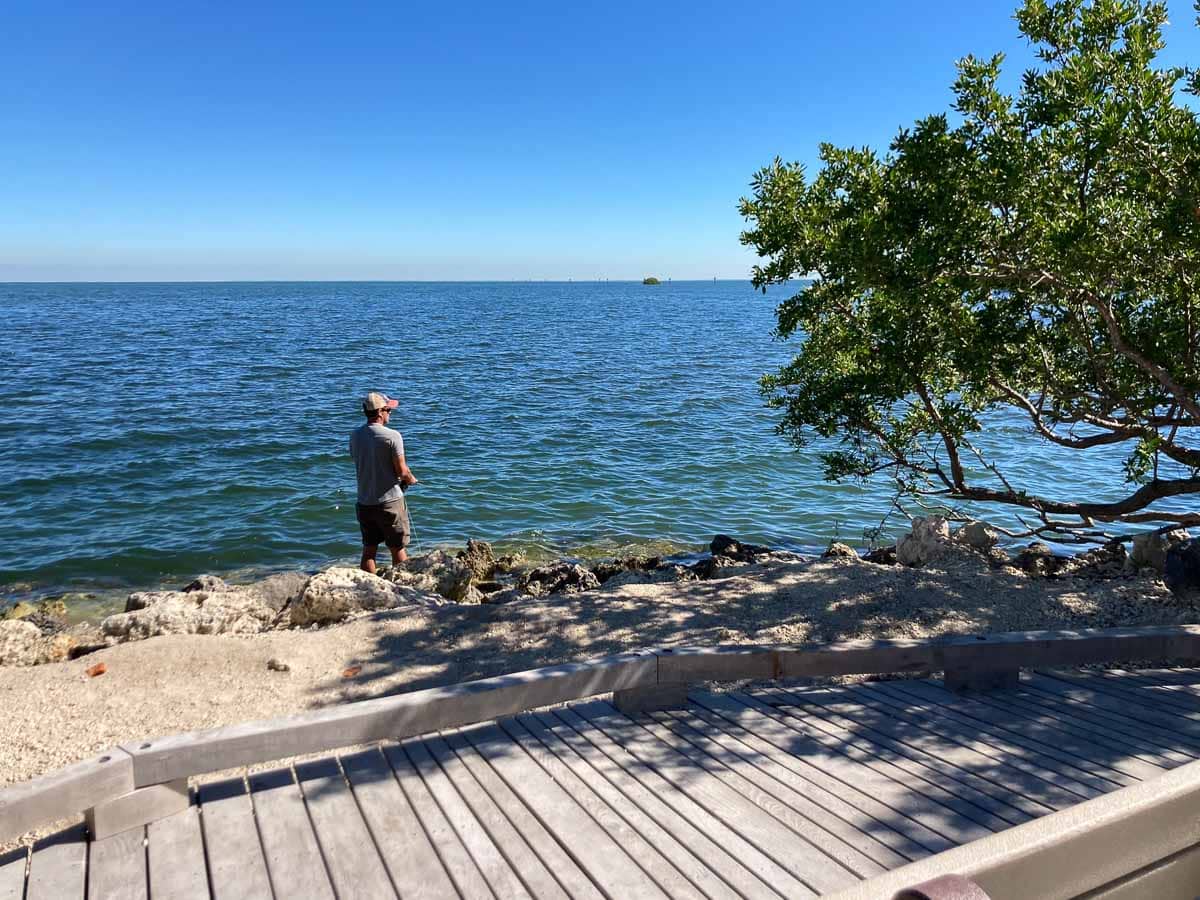
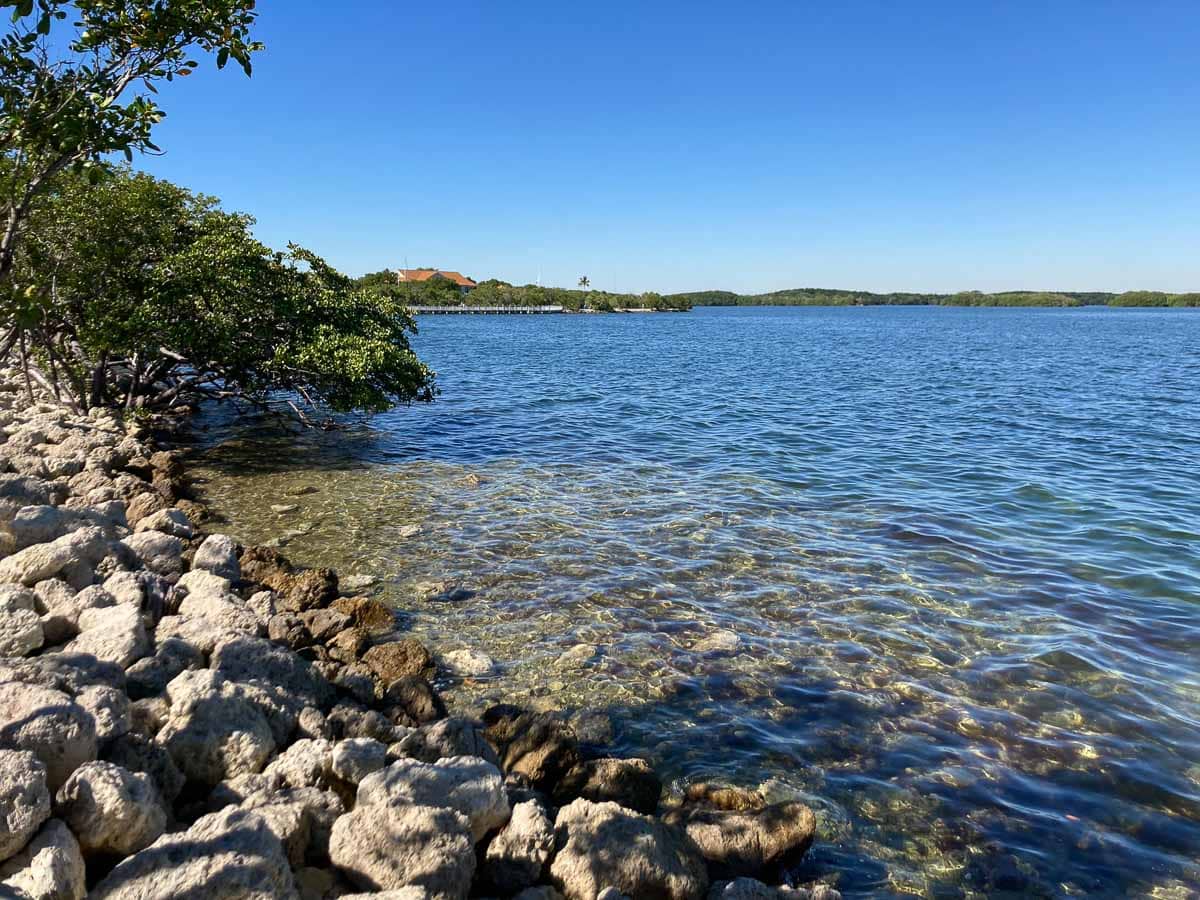
People have fished the shallow waters of Biscayne Bay for thousands of years.
“For ancient peoples like the Tequesta, it was a way of life. Today, we enjoy fishing as a way to relax and appreciate the outdoors,” the National Park Service says.
There are several fishing restrictions and regulations in Biscayne National Park, though, so check the park website for more details.
You can fish from the Convoy Point Jetty, which is basically the only permitted fishing zone on the mainland, as well as in most of Biscayne Bay, and near almost all keys.
9. Snorkel or Scuba Dive in Spectacular Coral Reefs
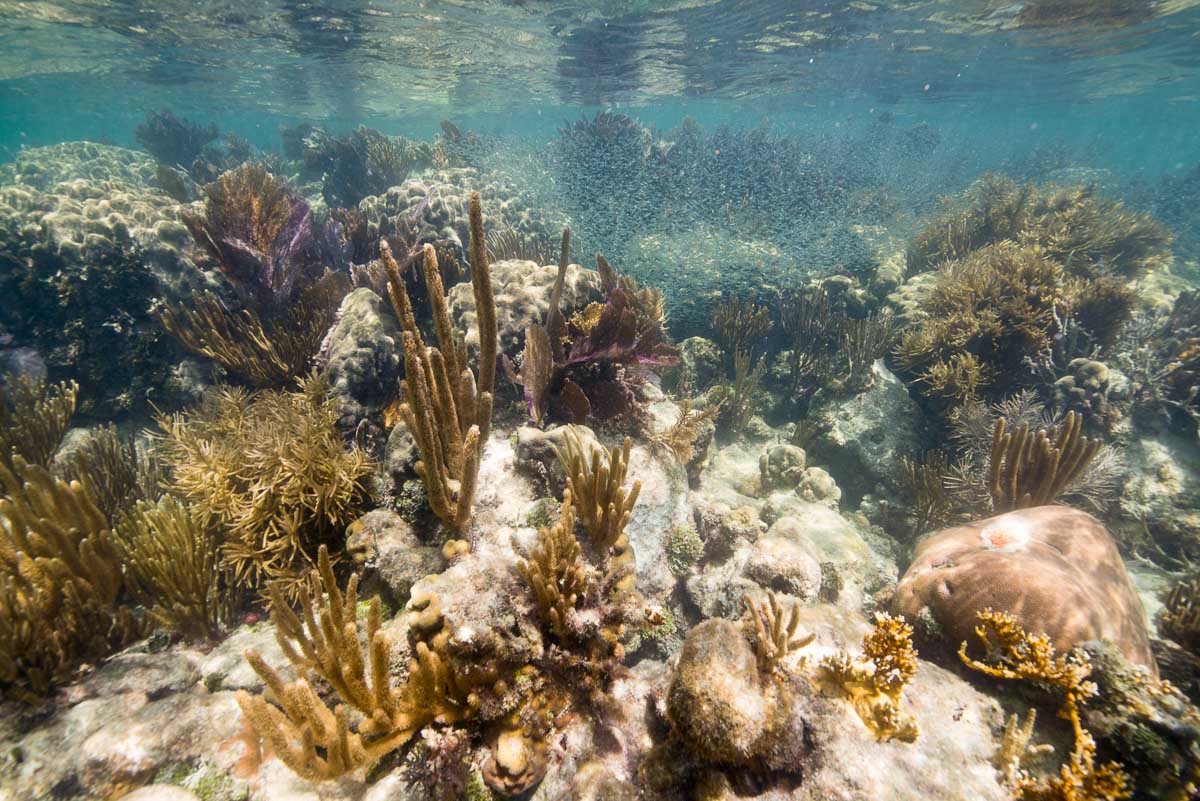
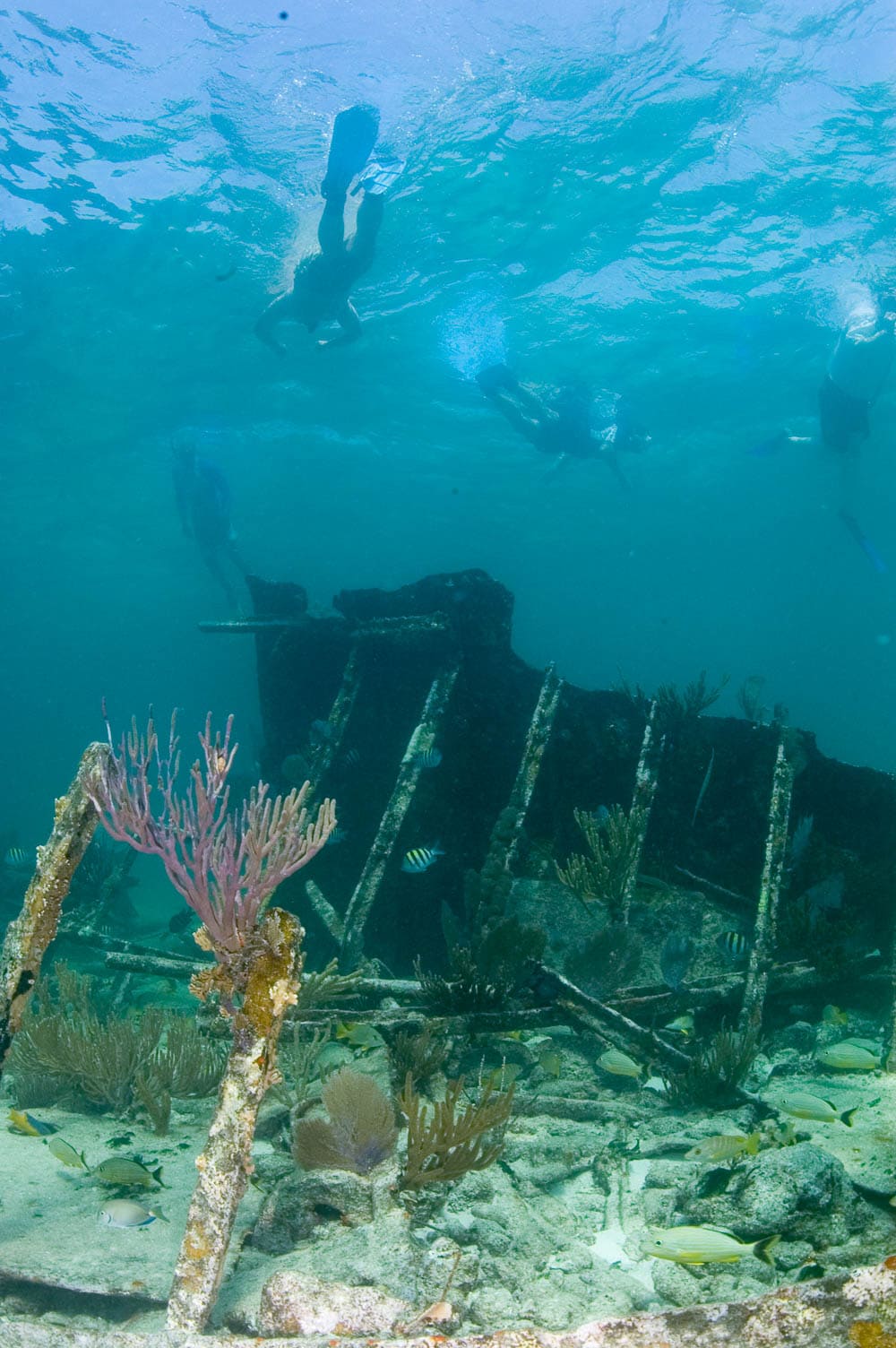
Without question one of the best things to do in Biscayne National Park is exploring the park’s spectacular underwater world.
The captain on my boat tour put it this way: “Visiting Biscayne National Park without snorkeling is like going to the movies and just walking around the lobby of the theater.”
And indeed, the vast majority of this park is below the water’s surface.
Whether you’re going snorkeling or scuba diving, you’ll be blown away by the incredible diversity of marine life in these crystal-clear waters. Biscayne does, after all, protect a portion of one of the largest barrier coral reefs on the planet.
You can see everything from colorful corals, sponges, crustaceans, and starfish to sea turtles, rays, and literally hundreds of different subtropical fish.
Additionally, Biscayne may not have many hiking trails, but it does have its very own underwater trail.
The Maritime Heritage Trail is a submerged route past six historic shipwrecks, which span almost a century and a wide range of ship types. The trail also includes the striking Fowey Rocks Lighthouse.
- Arratoon Apcar shipwreck, sank in 1878 – suitable for both snorkeling and scuba diving
- Fowey Rocks Lighthouse, constructed in 1878 – suitable for both snorkeling and scuba diving
- Erl King shipwreck, sank in 1891 – best suited for scuba diving only
- Alicia shipwreck, sank in 1905 – best suited for scuba diving only
- Lugano shipwreck, sank in 1913 – best suited for scuba diving only
- Mandalay shipwreck, sank in 1966 – suitable for both snorkeling and scuba diving
- Unnamed 19th-century wooden sailing vessel wreck – suitable for both snorkeling and scuba diving
See the Biscayne National Park Institute website for available snorkeling and scuba trips in Biscayne National Park.
10. Look For Wildlife
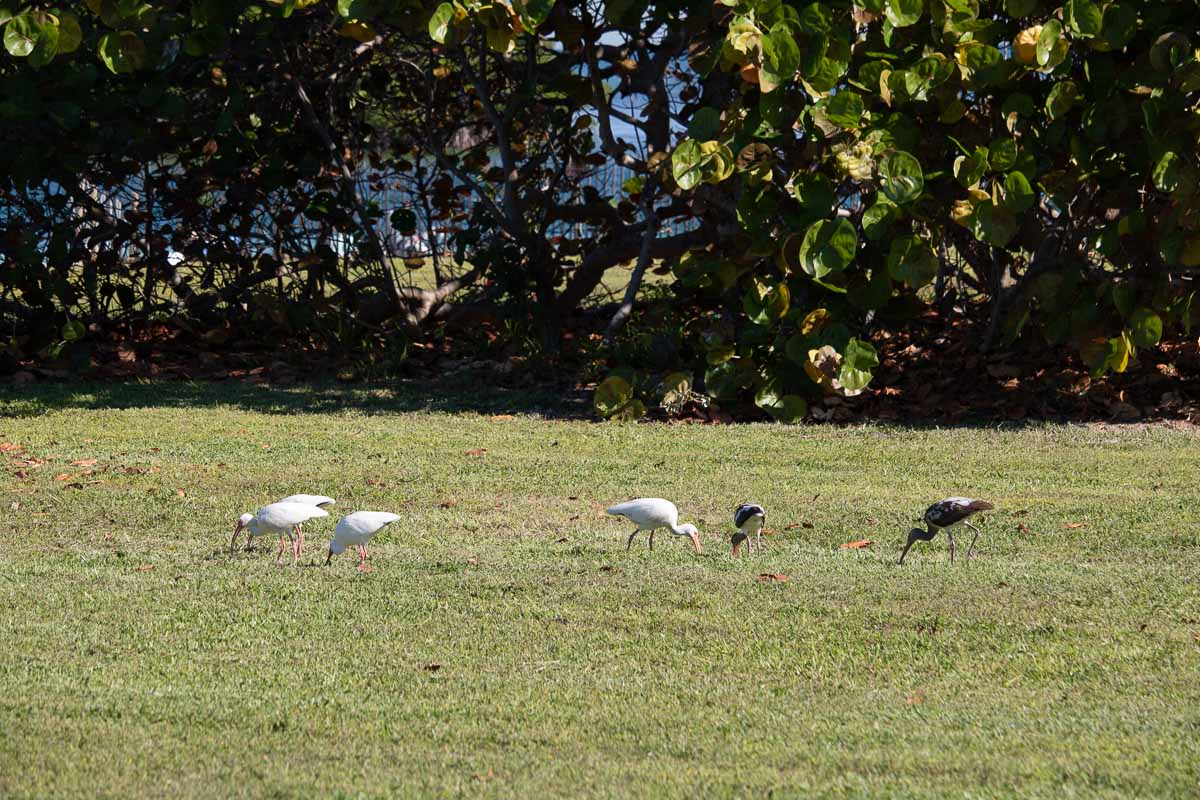
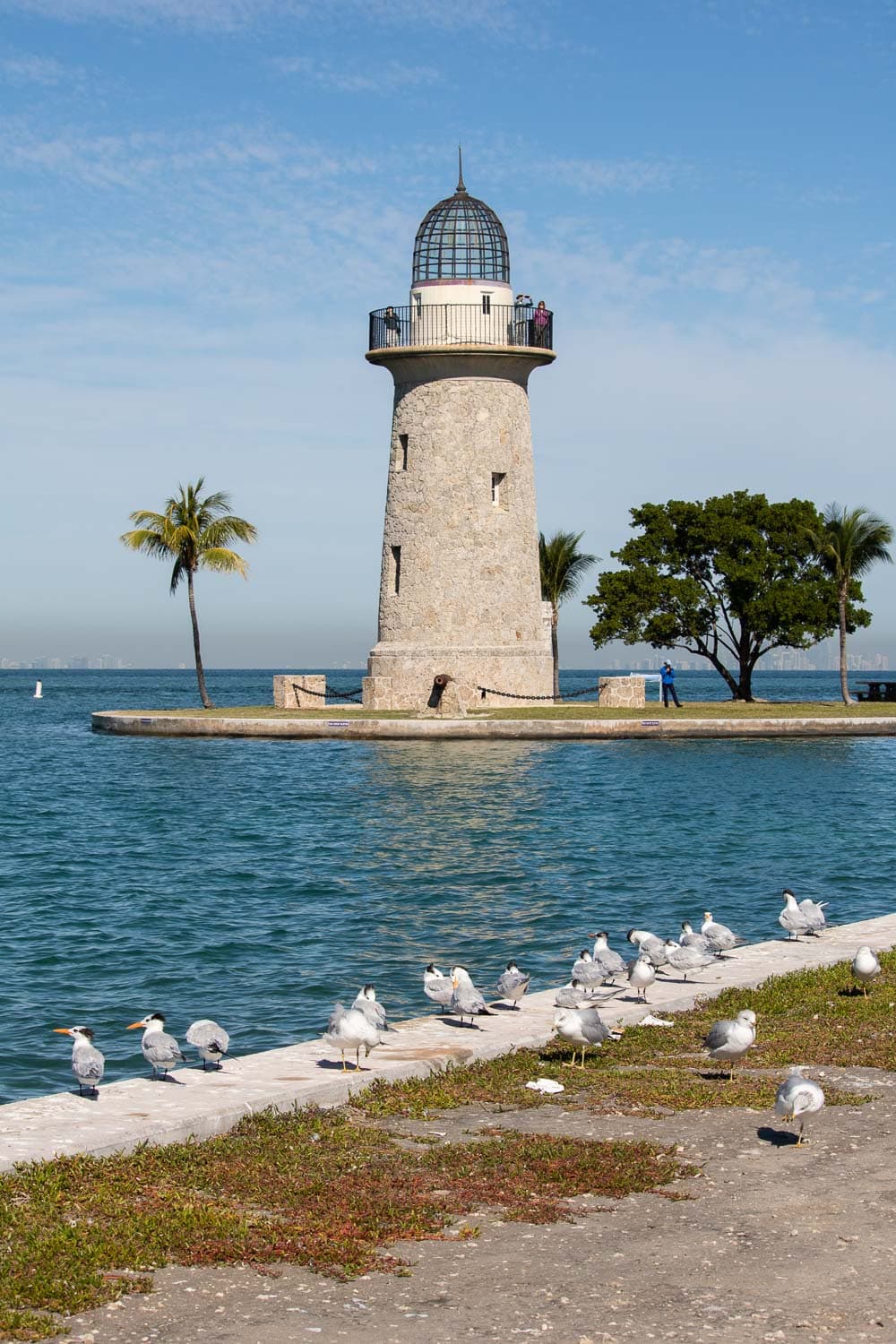
Besides underwater marine life viewing while snorkeling or scuba diving, there’s also excellent wildlife viewing above the water’s surface. In fact, looking for wildlife is one of the most popular things to do in Biscayne National Park.
At Convoy Point, look for large animals such as manatees and even crocodiles, which are occasionally seen in the area’s shallow waters. And just like nearby Everglades National Park, Biscayne is home to an exceptional variety of birds.
Bird watching in Biscayne National Park can be done anywhere in the park, from the Convoy Point mainland to the vast expanse of Biscayne Bay and small islands like Boca Chita Key, Elliott Key, and Adams Key.
Below is a non-exhaustive overview of birds you may see at various locations throughout the park. All these locations are part of the Biscayne Birding Trail, a partnership between the national park and the Tropical Audubon Society.
- Convoy Point: northern mockingbirds, yellow-crowned night-herons, mangrove cuckoos, terns, double-crested cormorants, brown pelicans, warblers, black and turkey vultures, and several wading birds, including white ibis, herons and egrets.
- Boca Chita Key: brown pelicans, Wilson’s plovers, and wading birds, especially white ibis
- Elliott Key: brown pelicans, red-shouldered hawks, sandpipers, gulls, terns, warblers, woodpeckers, and wading birds.
- Jones Lagoon: huge colonies of nesting wading birds.
- Fowey Rocks Lighthouse: petrels, shearwaters, magnificent frigatebirds, peregrine falcons (in spring), brown boobies, and brown pelicans.
- Stiltsville: gulls, terns, and “an astonishing number of double-crested cormorants” at the shacks, according to the National Park Service.
11. Go Camping on a Florida Key
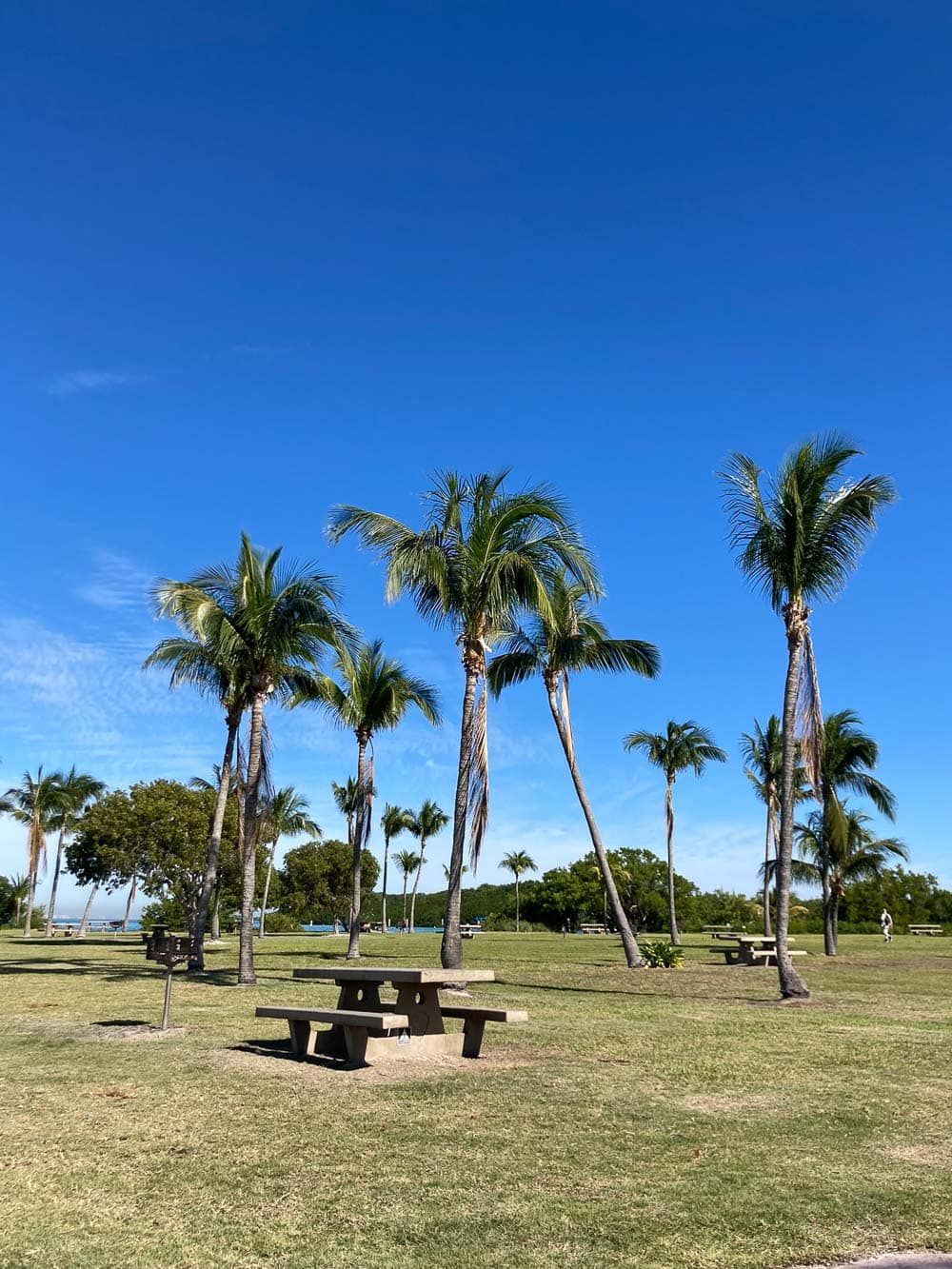
That’s right, you can go camping in Biscayne National Park, too!
The park has two campgrounds, both of which are located on islands, respectively Boca Chita Key, the most popular island in the park, and Elliott Key, the largest island in the park.
The only way to get to these campgrounds is by boat. There are no services on either island, which means you need to bring everything you might need with you. Some (basic) facilities are available, though.
- Boca Chita Key Campground has a grassy camping area right next to the harbor, beautiful waterfront views, picnic tables, and grills. There are flush toilets, but no drinking water, sinks, or showers. Prices are $25/night for camping only and $35/night for docking and camping.
- Elliott Key Campground has picnic tables and grills, as well as restrooms with sinks and cold water showers. There is drinking water, but visitors are encouraged to bring sufficient water with them in case the system goes down. Prices are $25/night for camping only and $35/night for docking and camping.
See the park website for rates, reservations and more information about camping in Biscayne National Park.
Additional Biscayne National Park FAQs
I answered the most important questions related to visiting Biscayne National Park above, but here’s a bit more information about the park.
Where Does the Name Biscayne Come From?
There are two different theories that explain the name Biscayne.
The first theory, which is a popular one, says that Biscayne Bay was named after the Bay of Biscay, a bay in the Atlantic Ocean that includes the north coast of Spain and southwest coast of France.
The second theory originates from the memoirs of Hernando de Escalante Fontaneda, a Spanish shipwreck survivor who lived among the area’s Native Americans for 17 years. In 1575, he wrote about another Spanish sailor, who went by the nickname El Vizcayno or El Biscayno.
Whichever theory is true, fact is that 17th-century maps did show an island named Cayo de Biscainhos, which is now known as Key Biscayne. The name Biscayne Bay became common in the late-19th century.
Is There Cell Phone Service in Biscayne National Park?
Yes, there is cell phone service at Convoy Point, while the Dante Fascell Visitor Center also provides free WiFi.
Cell service is variable elsewhere in the park, including roads leading into the park, in Biscayne Bay, and on the islands. I recommend checking with your provider to find out if park areas are covered.
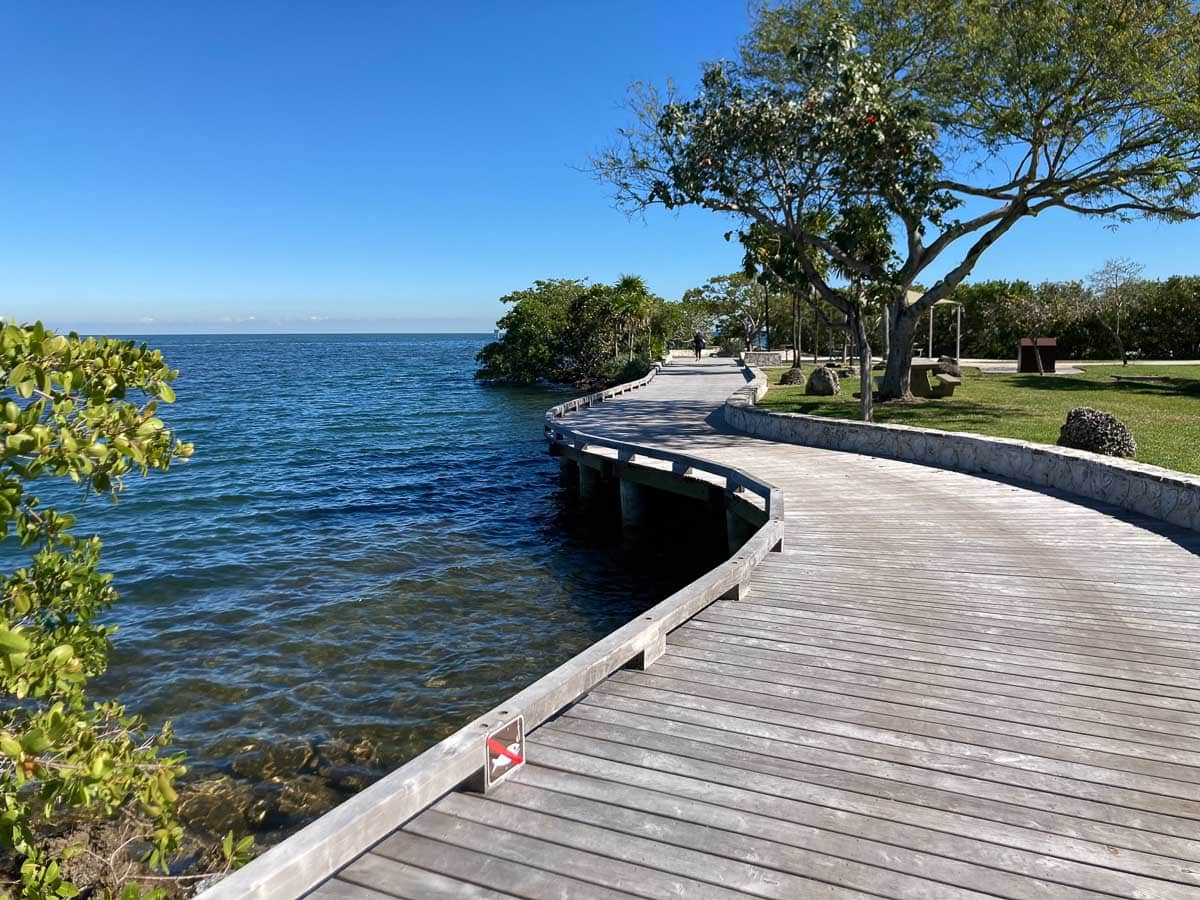
Are Pets Allowed in Biscayne National Park?
Yes, pets are allowed in certain places in Biscayne National Park.
Specifically, you can walk your pet on the Convoy Point grounds (except inside the Dante Fascell Visitor Center) and on Elliott Key. They aren’t permitted anywhere else in the park.
Pets must always be on a leash that’s no longer than 6 feet and under your control. You must pick up and dispose of pet waste immediately.
Also remember that Florida law, which also applicable within Biscayne National Park boundaries, regards leaving a pet in a parked vehicle as animal cruelty.
Is Biscayne National Park Always Open?
Because the park encompasses much of Biscayne Bay, which is impossible to close, the waters of Biscayne National Park are open 24 hours a day, every day of the year. There are no holiday closures or seasonal exceptions to this rule.
However, the park grounds at Convoy Point do have opening times. You can access this area, the only place in the park you can get to by car, every day between 7 am and 5:30 pm.
The Dante Fascell Visitor Center, which is located at Convoy Point, is open daily from 9 am to 5 pm.
More About Biscayne National Park
Have You Ever Been to Biscayne? What Were Your Favorite Things to Do in Biscayne National Park? Share Your National Parks Experience Below!
More About the National Parks in Florida
- National Parks Near Miami
- Best Things to Do in Dry Tortugas National on a Day Trip
- Best Places to See Wildlife in Everglades National Park
- Famous Birds of the Everglades (and Where to See Them)
- Where to See Alligators and Crocodiles in the Everglades
- Top 3 Bike Trails in Everglades National Park
- 12 Best Places to Visit on the Everglades Main Park Road
- Top Things to Do in Flamingo, Everglades National Park
